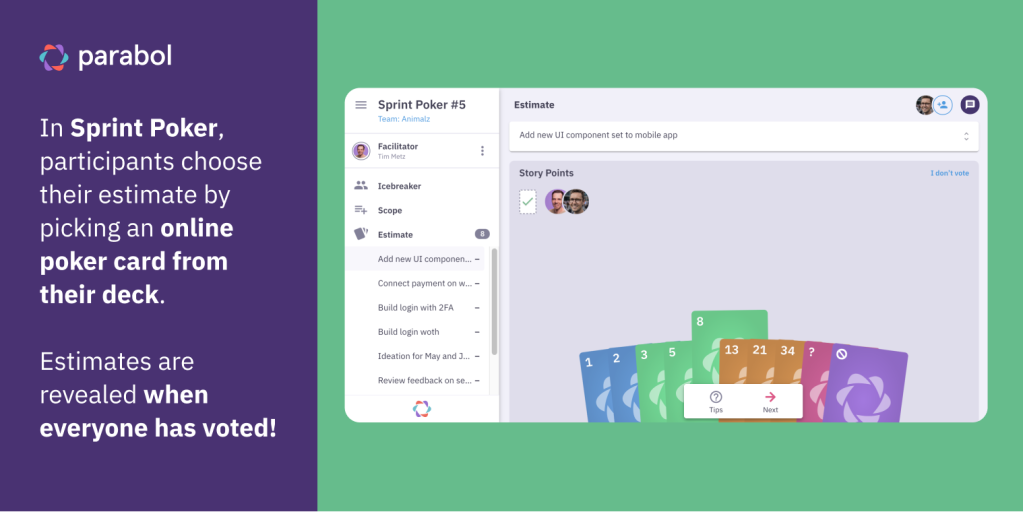How to Run an Online Planning Poker Meeting
Complete Guide for Remote and Hybrid Teams

Many Scrum teams meet during each Sprint to estimate the required effort for completing upcoming tasks. Traditionally, teams do this during or just before Sprint Planning.
But estimation meetings have a reputation for being tedious and tiring affairs that distract from ‘real work’, like coding, writing, or designing. What’s more, doing estimation meetings as a remote or distributed team can be difficult.
In this guide, we’ll walk through how you can run a great online planning poker session, whether you’re a co-located, hybrid, or fully remote team!
What is planning poker?
Planning poker is a task or project estimation method in which teams come together to estimate how large or small various projects are using a set of poker cards.
The process helps teams to ensure everyone is assigned an achievable amount of work for future sprints.
In planning poker, teams review a selection of user stories or tasks from the product backlog. Then each participant individually estimates how much effort that task will involve. Teams do this by playing cards with different values from a customized deck.
Everyone chooses their card anonymously, before they are all revealed simultaneously. This helps teams have an honest conversation about how much work selected tasks or user stories require to complete. What follows is a discussion of everyone’s estimates so teams can get on the same page about the effort required to complete pieces of work.
Why use planning poker?
There are a few reasons why you might want to try planning poker compared to other estimation techniques.
- 👾 Gamify estimation: Compared to boring estimation meetings of the past, planning poker estimation makes meetings fun by gamifying the process with custom card decks, different estimation methods to choose from, and an interactive process.
- 🤗 Include everyone: Planning poker gives every team member a voice and an equal opportunity to shape the conversation.
- 💡Hear diverse opinions: When everyone has the opportunity to vote, the whole team gets to benefit from diverse perspectives. Perhaps one team member has done something similar before and has additional context others don’t have.
- ⚓Counter anchoring bias: Planning poker helps teams prevent anchoring bias, which is when people adjust their estimates based on the estimates of those who’ve spoken before them, by having everyone pick a card anonymously and reveal it at the same time.
- 🔍 Build shared context: Planning poker helps teams get on the same page about work before going into Sprint Planning. For new or junior team members, attending planning poker can help to build context and onboard more quickly.
- 🧩 Customize your approach: Unlike other estimation techniques, planning poker gives teams a lot of flexibility to choose a custom estimation method or estimation scale that suits your team best.
Finally, planning poker estimation works well remotely and there are tools on the market to help teams estimate online.
For example, when you run your estimation meetings online with a tool like Sprint Poker, you even save time because you can streamline or automate many facilitation duties.
1. Prepare your planning poker session
There are a few things you’ll need to do before you get going with your planning poker meeting:
- 💡 Check everyone is familiar with the user stories or tasks that will be estimated
- 🃏 Pick an estimation method and scale
- ❓ Ensure everyone understands how the process works
As a remote team, you can do much of this preparation work asynchronously, before the meeting begins.
A. Review your product backlog
Start by ensuring the backlog items you will estimate are sufficiently detailed for participants to make accurate estimates.
In his paper on planning poker, Bob “Agile Bob” Hartman from Agile for All recommends asking Quality Assurance (QA) and Development leads to review tasks before your planning poker session and encouraging them to add relevant details. It’s hard to make an educated estimate if important context or detail is missing.
When your backlog items are sufficiently detailed, make a list of the ones you want to select for estimation during the meeting. Our Sprint Poker tool lets you import your tasks and stories directly from product backlog in Jira or GitHub before the meeting begins, so they’re ready for the team to estimate.

To complete the preparation of your planning poker session, ask attendees to read through all the tasks you’ve selected before the meeting starts.
📚 Further reading
B. Pick an estimation method
There are two common estimation methods for planning poker. You’ll need to decide which one to use before you get started:
- ⚖️ Estimated Effort: Instead of estimating tasks by the amount of time they will take to complete, you can evaluate them based on effort. Think easy-intermediate-difficult instead of one day, five days, or 30 days. This approach speeds up planning as people don’t get stuck on discussing details. (“I think this task will take 20 days, not 21.”)
- 🏋️ Weighted Shortest Job First: With this approach, you estimate each item twice. First for Estimated Effort, then for the expected value it will bring your project. With these two estimates done, you have an automatically prioritized list starting with the highest value and lowest effort tasks.

C. Pick a scoring method
Since planning poker practitioners shy away from estimating by time (turns out humans are pretty bad at it), you also need to decide what measure – often referred to as the scale – you will use to estimate a task’s effort. These are the numbers or units you will see on your playing cards.
The default scale for planning poker is the Fibonacci scale, a sequence of numbers in which each is the sum of the two preceding digits – 1, 2, 3, 5, 8, 13, 21, and 34. Using this approach, you would play the “1” card for a task that hardly requires any effort and “34” to indicate an impossible amount of work.
Other common scales include T-shirt sizes (👕 XS, S, M, L, XL), priorities (P1, P2, P3, P4, P5), five fingers (1, 2, 3, 4, 5), and even small and large animals – more on those later, promise. 🐶
Before you get started, talk to your team about the estimation method and the scale you’ll use, along with an explainer of any other confusing Scrum terms that might come up.
📚 Further reading
2. Cast your votes to estimate tasks
Assuming you’ve selected what you’ll estimate in advance, you’re ready to start playing planning poker with your team! Now it’s time to start estimating using poker cards.
Only people with awareness and context of a task should vote. It helps to have more people involved than just those doing the actual work, as insiders’ estimates tend to be too optimistic – an effect known as the planning fallacy. At the same time, people with hardly any knowledge of the task or project can’t give a helpful estimate or drag out the discussion phase for too long with their questions.
The meeting facilitator should start by reading out the task that’s up for estimation and let participants ask clarifying questions to help form their estimate. In Sprint Poker, participants can indicate they have a question by playing the question mark card. Team members can also enter questions and comments in the discussion thread on the right side of the screen.

When you’ve addressed questions, everyone picks a card with the value that most closely matches their estimated size for the task.
Nobody sees anyone else’s selection until everyone has voted. Hidden voting helps to prevent anchoring bias that may skew estimates. This bias is described in detail by psychologists Amos Tversky and Daniel Kahneman in their book “Thinking, Fast and Slow”:
“[Anchoring bias] occurs when people consider a particular value for an unknown quantity before estimating that quantity. What happens is … the estimates stay close to the number that people considered—hence the image of an anchor. If you are asked whether Gandhi was more than 114 years old when he died you will end up with a much higher estimate of his age at death than you would if the anchoring question referred to death at 35.”
In the context of planning poker, this means if you went around in a circle and knew the person before you picked an eight, you’d be more likely to choose eight or a number close to it, too.
3. Discuss estimates and count votes
Once everyone’s cards are on the table, it’s time to start a discussion. With a virtual planning poker tool like Sprint Poker, you can see everyone’s estimates clearly and decide on the need for discussion or subsequent rounds of voting to reach a consensus.
If there’s little variation in everyone’s estimates for a task, you can take the average and move on to the next item. In his original paper, planning poker inventor James Grenning says that simply taking an average saves teams time by cutting the required discussion time for most stories from 10, 20, or 30 minutes to just “a minute or so.”
When you do have significant estimation differences, let the folks with the highest and lowest estimates kick off a discussion by clarifying their thinking and then letting others weigh in.
If the team can’t reach an agreement, hold another voting round to see if the discussion has reduced the variation in everyone’s estimates. When that’s still not the case, Grenning has a straightforward recommendation: “If you can’t get consensus, don’t sweat it. It is only one story out of many. Defer the story, split it, or take the low estimate.”
Estimates reflect the effort a task will likely involve so teams can plan their work for the next sprint. They’re not promises about a task’s completion time or date, so managers shouldn’t treat estimates as deadlines.

Remote teams can also hold the entire voting and discussion process asynchronously with Sprint Poker. Open up Sprint Poker’s voting for a specific period (e.g. 24 hours) and then do the same for the discussion phase afterwards.
It will take longer to complete the entire process, but it allows everyone to participate without having to wake up at odd hours if your team is spread across difficult time zones.
4. Summarize the planning poker meeting outcome
There’s a lot to keep track of during a planning poker session. You might forget something crucial, like this Scrum Master we spoke to:
“At the end of the meeting, there’s so much going on that I often forget to add the final point estimates back into our tracking tool.”
Run through this checklist at the end of your meeting to make sure you don’t overlook anything important when wrapping up:
- 📝 Note down the final estimates for each task.
- ✅ Submit the estimates into your tracking tool’s backlog.
- 💬 Summarize decisions and other essential topics anyone raised.
- 🤔 Reflect briefly on the meeting itself and discuss opportunities to improve future sessions.
- 🔎 Define and assign follow-up actions if there are any.
When you run your session with Sprint Poker, most of these steps are covered automatically. All participants can reference estimates and discussions in the tool at any time after the meeting, and they instantly receive a meeting summary by email.

Sprint Poker also lets you post the final estimates automatically to Jira or GitHub, so you don’t have to worry about manually copying and pasting after the meeting.
Don’t forget to have fun
The goal of planning poker is not just getting more accurate task estimates; it should also make the process of getting accurate task estimates enjoyable.
To crank up the fun factor, ask your team to create custom estimation scales and values for your poker cards. From Chihuahuas to Great Danes, strawberries to watermelons, or mopeds to monster trucks, the possibilities are limited only by your imagination.
Planning Poker FAQ
Here are the answers to some of the most commonly asked planning poker questions:
What is the expected output of a planning poker meeting?
The expected output of a Planning Poker meeting is consensus regarding the relative complexity or effort required to complete a set of tasks or user stories. The primary goal is to ensure that the team has a shared understanding of the work to be done and can use estimates to plan and prioritize their work effectively. When each user story has an associated estimate, teams can better understand how many of their tasks “fit” inside the current sprint.
Which scale is typically used for planning poker?
The fibonacci scale or modified fibonacci scale is the most popular planning poker scale. However, you are free to choose from simpler options as well, such as T-shirt sizes and five fingers, if you want to keep it simple. Parabol’s Sprint Poker tool has a range of scales built in so you can make your estimation process easier.
What is the correct order of steps during planning poker?
The correct order of steps during planning poker is:
- Shortlist the user stories or tasks you want to estimate in planning poker
- Choose the estimation scale you will use (Fibonacci, T-shirt sizes, fiver fingers, etc).
- Read out the details of the first user story or task you will estimate
- Ask every team member to give an estimate of the effort involved to complete the task
- Compare the estimates and discuss differences to arrive at a final estimate
- Document the final estimate in your product backlog item
Parabol’s Sprint Poker tool guides you through this process automatically, making it easier to have a successful planning poker meeting.








